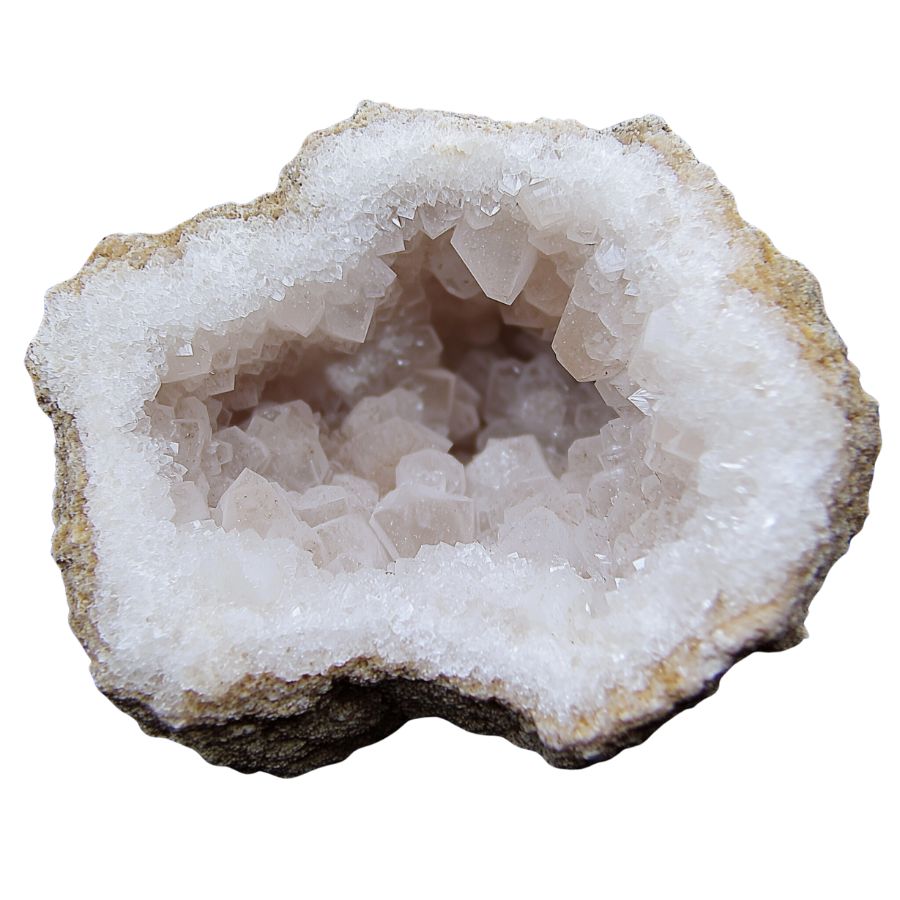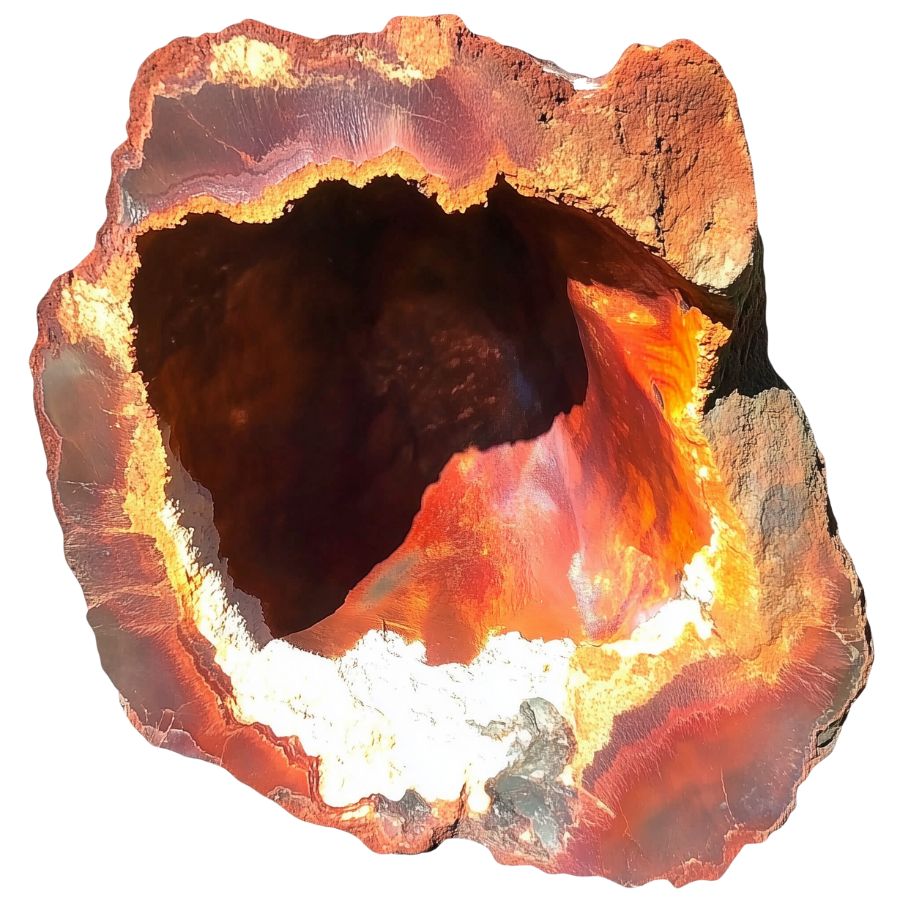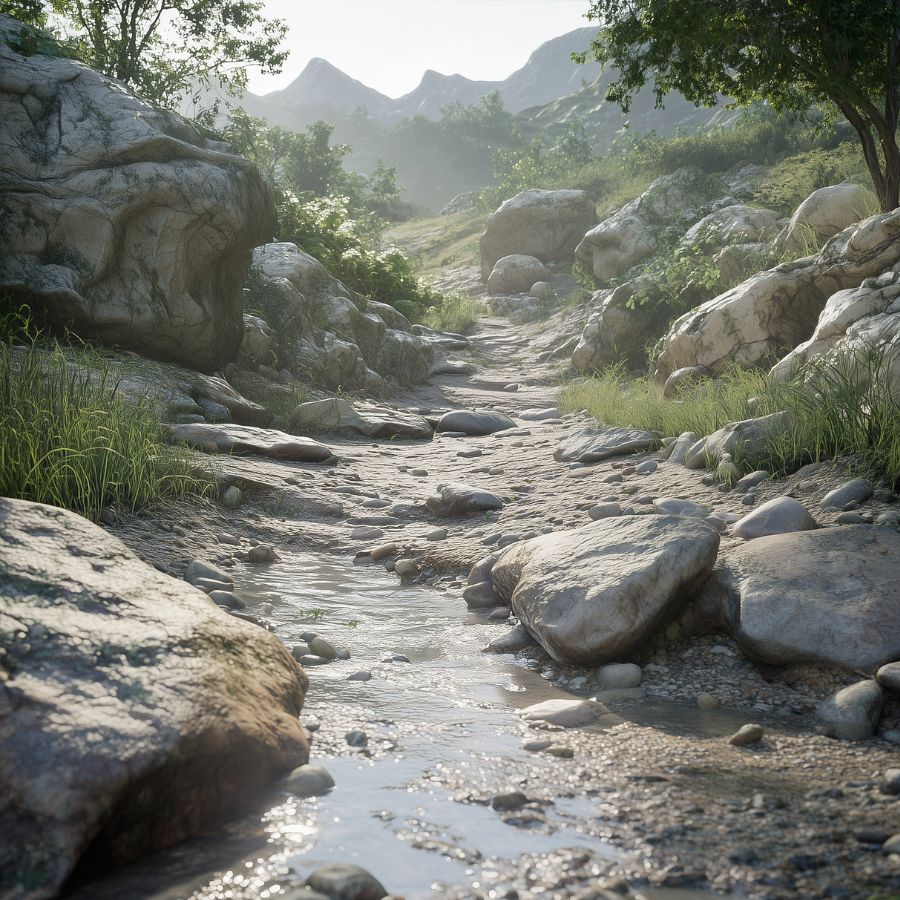Geodes are like nature’s surprise eggs, filled with sparkling crystals inside a plain-looking rock. Our state is a treasure trove for these hidden gems, with its many different landscapes that make it perfect for rock hounds.
If you’re itching to crack open your own crystal-filled wonder, you’re in the right place!
This article will show you the best spots in our state to find geodes. We’ll also share some handy tips to make your geode hunting adventure a success.
So grab your hammer and get ready to discover the beauty hiding in ordinary-looking rocks all around this state!
How Geodes From Here

Geodes form when bubbles in volcanic rocks or spaces in sedimentary rocks get filled with minerals over time.
First, water rich in minerals like quartz or calcite seeps into the hollow space. As the water evaporates, it leaves behind the minerals, which slowly build up layer by layer.
Eventually, these minerals create a crystal lining inside the geode. The outer shell stays rough, while the inside becomes a sparkling treasure.
The process can take thousands, even millions, of years, making each geode a unique and beautiful time capsule of Earth’s natural forces.
The Types Of Geodes Found in the US
There are many fascinating varieties of geodes that can be found across the United States, including in our own state. Each type is distinctly beautiful and intriguing:
Amethyst Geode

Amethyst geodes look plain on the outside, like a potato. But crack them open, and you’ll find stunning purple crystals. These crystals can be light lavender or deep purple.
The structure of crystals inside can vary widely. Some are tiny and densely packed, creating a sparkling surface. Others form large, distinct points that jut inwards.
The color range is impressive too, from pale lilac to deep royal purple. Some amethyst geodes develop unique features. “Stalactites” of amethyst might hang from the top.
In rare cases, you might find a water bubble trapped inside, a remnant from the geode’s formation millions of years ago.
Citrine Geode

Citrine geodes are eye-catching rocks with golden yellow to orange crystals inside. They sparkle when light hits them, looking like sunshine trapped in stone. The colors come from iron mixed in with the quartz.
Unlike many gemstones, citrine’s color is often evenly distributed throughout the crystal.
Most citrine on the market isn’t natural. It’s actually heat-treated amethyst. This process turns the purple amethyst into vibrant citrine. Natural citrine is rarer and often has a more subtle color.
Pyrite Geode

Ever cracked open a rock and found gold inside? Well, not real gold, but something that looks just like it. That’s a pyrite geode. Pyrite is called “fool’s gold” because it’s so shiny and golden.
Inside these geodes, pyrite forms in cool shapes. Sometimes it’s perfect cubes. Other times its clumps or even round balls called “pyrite suns”.
Pyrite has a fun history. People have been mixing it up with real gold for thousands of years. That’s how it got its nickname.
Selenite Geode

Selenite geodes stand out from the crowd. They’re white and see-through, with a glassy look. When you open one up, you’ll see crystals that look like they’re made of ice or moonlight.
Unlike harder geodes, selenite is soft. You can scratch it with your fingernail! This softness means you need to handle it carefully. But it also means selenite can be shaped into beautiful forms easily.
One cool thing about selenite is how it plays with light. Hold it up to a lamp, and you’ll see the light shine right through it. This makes selenite geodes popular for decorative lamps and light fixtures. They add a magical glow to any room.
Celestite Geode

Celestite geodes are like pieces of sky trapped in rock. Their crystals are typically a delicate blue, ranging from almost colorless to deep sky blue. In rare cases, celestite can form in other colors. Pink celestite is highly prized by collectors.
One unique feature of celestite is its perfect cleavage. This means the crystals can be easily split into rhombohedral shapes.
These geodes form in a unique way. They start as nodules of a soft mineral called alabaster. Over time, this dissolves and is replaced by celestite crystals. Some celestite geodes are huge, like the famous Crystal Cave in Ohio.
Celestite isn’t just pretty to look at. It’s used to make strontium, an element with many uses. You’ll find strontium in fireworks, where it creates red colors. It’s also used in making TV screens and ceramics.
Jasper Geode

Jasper geodes are the chameleons of the mineral world. They can appear in almost any color, often with multiple hues in a single specimen. Patterns can range from solid colors to intricate swirls, bands, or spots.
One fascinating type is picture jasper. These geodes contain patterns that resemble landscapes, with “skies,” “mountains,” and “rivers” visible in the stone. Each one is like a miniature painting created by nature.
Some jasper geodes contain orbicular patterns – spherical structures that formed as the jasper solidified. These create eye-catching bull’s-eye or flower-like designs in the stone, making each piece truly one-of-a-kind.
Carnelian Geode

Carnelian geodes have vibrant orange to reddish-brown colors. They can be somewhat see-through, which makes them look even more interesting. The bright colors come from the iron in the stone.
These geodes stand out from other similar stones. They’re brighter than sard, which is usually darker and more brownish. And unlike agate, carnelian doesn’t have bands or stripes.
Carnelian has been popular for a long time. Ancient Egyptians and Greeks used it to make special rings. It’s tough enough for everyday jewelry.
Some people heat or dye carnelian to make its color even brighter. This makes it a favorite for both rock collectors and jewelry lovers.
Fluorite Geode

Fluorite geodes are like nature’s rainbow. They come in many colors – purple, green, blue, yellow, and sometimes even clear or black. When you open one up, you might see cube-shaped or eight-sided crystals inside.
What makes fluorite special is that you can often see more than one color in a single stone. This is different from many other geodes. Also, fluorite has a unique way of splitting when it breaks.
A cool fact: fluorite glows blue under ultraviolet light. This was first discovered back in 1852. Because of its many colors and this glowing ability, fluorite is sometimes called the “most colorful mineral in the world.”
Scolecite Geode

Scolecite geodes are like tiny crystal caves. They’re usually white or colorless, but sometimes you might find pink, yellow, or green ones.
What makes them special is the crystals inside. They look like thin needles or delicate hairs, all pointing out from the center.
These geodes are different from others because of their crystal shape. Instead of blocky or chunky crystals, scolecite has these fine, hair-like ones. This gives them a unique, delicate look.
Scolecite has an interesting property – it can hold a lot of water in its structure. This means it can absorb and release water easily. This makes scolecite useful in various ways, not just as a pretty rock to look at.
Apophyllite Geode

Apophyllite geodes are like nature’s disco balls. They often have dark or black crystals inside a hollow rock. These crystals can be see-through or slightly cloudy, with cube-like or flat shapes.
What makes apophyllite geodes stand out is how the crystals form. They grow in round clusters that look like tiny disco balls. This unique formation is rare and makes them special to rock enthusiasts.
Collectors really prize these “disco ball” clusters. They’re not common, which makes them valuable to people who love unusual rocks. The way apophyllite crystals catch and reflect light adds to their appeal, making them fascinating to look at and study.
What Rough Geode Looks Like
Identifying a rough geode might seem tricky, but with a few tips, you can spot one even if you’re not a rock expert. Here’s how you can do it.
Look for a Rounded Shape

A rough geode often has a rounded or egg-like shape. It might not be perfectly round but look for a generally bulbous form.
When you’re out searching, skip the flat, jagged rocks. Geodes usually have smoother exteriors because they’ve been rolling around in rivers or other environments for a long time.
Check for a Dull, Bumpy Surface

The outside of a geode isn’t usually shiny. Instead, it’s dull, bumpy, and a bit rough.
Imagine a potato or a clump of dirt with some bumps and dents. That’s how a geode might look before it’s cracked open.
The outside won’t give away much of what’s inside, so don’t be fooled by its ordinary appearance.
Test the Weight

Pick up the rock. Does it feel lighter than it looks? That’s a good sign!
Geodes are hollow or partially hollow, which makes them lighter than solid rocks of the same size. If it feels unexpectedly light, you might have found something special.
Look for Tiny Crystals or Mineral Patches

Sometimes, you can spot small crystals or mineral deposits on the outside. These could look like tiny sparkles or specks of color.
While the outside of a geode is usually dull, a little peek of what’s inside might show through. Keep an eye out for these hints, especially if you’re in a known geode-rich area.
Tips on Where to Look
Once you get to the places we have listed below there are some things you should keep in mind when you’re searching:
Explore Riverbeds and Streams

Geodes often form in riverbeds or streams. Water flow smooths out their rough edges and deposits them in these areas.
When exploring, focus on gravel bars or the edges of rivers where rocks naturally gather.
Search in Sedimentary Rock Layers

Sedimentary rocks, like limestone, are prime spots for geodes. These rocks form in layers over time, trapping minerals inside.
Look for areas where sedimentary rocks are exposed, such as cliffs or road cuts.
Visit Old Mines or Quarries

Abandoned mines and quarries are excellent spots for geode hunting.
Workers often missed geodes while digging for other materials. Explore the tailings or leftover rock piles for hidden treasures.
Explore Hills and Rock Outcrops

Hills and rocky outcrops often reveal geodes. As erosion wears away the softer rock, it exposes the harder geodes.
Look for areas with exposed rocks and keep an eye out for rounded shapes.
The Best Places To Find Geodes in North Dakota

You’ve undoubtedly had a lot of difficulties locating geodes that naturally occur in North Dakota. This results from North Dakota being a state with fewer geodes than other states. There are no known places where you would have a high chance of finding one due to how uncommon they are.
On the other hand, we can advise you on the best places to look for geode-like rock and gem formations in the state.
Always Confirm Access and Collection Rules!
Before heading out to any of the locations on our list you need to confirm access requirements and collection rules for both public and private locations directly with the location. We haven’t personally verified every location and the access requirements and collection rules often change without notice.
Many of the locations we mention will not allow collecting but are still great places for those who love to find beautiful rocks and minerals in the wild without keeping them. We also can’t guarantee you will find anything in these locations since they are constantly changing.
Always get updated information directly from the source ahead of time to ensure responsible rockhounding. If you want even more current options it’s always a good idea to contact local rock and mineral clubs and groups
McHenry County

McHenry County, located in north-central North Dakota, is a rural area known for its rolling hills, fertile farmland, and unique geology. The county sits on the edge of the Missouri Plateau, which means it has a diverse range of geologic formations. You’ll find everything from rugged badlands and grassy prairies to winding rivers and sparkling lakes.
The terrain in McHenry County is characterized by its gently rolling hills, which were formed by the movement of glaciers during the Ice Age. The county is also home to several notable bodies of water, including Lake Darling and the Souris River.
Where we found geode-like formations
- In the Denbigh area, you can locate quartz gemstones in the regional gravels of the Mouse River, southwest to Velva.
DON'T MISS OUT ON ANY GREAT FINDS!
While you're out searching for Geodes you're going to find a lot of other interesting rocks and minerals along the way. The last thing you want to do is toss out something really interesting or valuable. It can be easy to misidentify things without a little guidance.
We've put together a fantastic field guide that makes identifying 140 of the most interesting and valuable rocks and minerals you will find REALLY EASY. It's simple to use, really durable, and will allow you to identify just about any rock and mineral you come across. Make sure you bring it along on your hunt!
Pembina County

Pembina County, located in the northeastern corner of North Dakota, is a unique area known for its diverse geology and stunning natural beauty. The county sits on the edge of the ancient Pembina Mountains, formed over 500 million years ago and contains some of the oldest rocks in North America.
The terrain in Pembina County is varied, with everything from lush river valleys to rugged, rocky outcroppings. The Pembina Gorge, located in the western part of the county, is a particularly beautiful area with cliffs, cascading waterfalls, and winding rivers. The county is also home to several notable bodies of water, including Lake Renwick and the Tongue River.
Where we found geode-like formations
- Quartz crystals are found in the deltas of the Pembina, Elk, and Sheyenne rivers.
Sheyenne River

The Sheyenne River, located in central North Dakota, is a winding waterway famous for its beautiful scenery and rich geological history. The river flows through a diverse landscape of grassy plains, wooded forests, and rugged badlands, offering a range of natural beauty and outdoor activities.
The geology of the Sheyenne River is particularly interesting, as it’s home to several unique rock formations and fossil sites. The area is known for its rich deposits of dinosaur fossils and has also yielded several important geological discoveries over the years.
Where we found geode-like formations
- You can locate some quartz gemstones along the Sheyenne River’s gravel bars.
Ward County

Ward County, located in north-central North Dakota, is a diverse area known for its rolling hills, expansive prairies, and unique geological formations. The county is situated on the edge of the Missouri Plateau, which means it has a rich variety of geologic features.
The terrain in Ward County is characterized by its gently rolling hills, formed by glaciers’ movement during the Ice Age. The area is also home to several notable bodies of water, including Lake Darling and the Souris River. These waterways offer a range of recreational activities.
Where we found geode-like formations
- Quartz gemstones are abundant in numerous area gravel pits of Minot.
Travel to Whitewood Creek

Travel to the south in South Dakota, a nearby state with more locations for naturally occurring geodes. One of the great places to visit to find geodes is Whitewood Creek.
Whitewood Creek is a picturesque western South Dakota waterway known for its clear, sparkling waters and stunning natural beauty. The creek flows through a diverse landscape of rocky canyons, grassy meadows, and wooded forests, offering a range of outdoor activities and recreational opportunities for visitors to enjoy.
The geology of Whitewood Creek is particularly interesting, as it’s home to several unique rock formations and geological features. The area is known for its rich deposits of gold and other precious minerals and has a rich mining history that dates back to the early days of the Wild West.
Where we found geodes at Whitewood Creek
- You can successfully look for geodes on the banks of Whitewood Creek, where these rocks are abundant.
Common North Dakota Geode-Hunting Questions

We wanted to make sure to address the following concerns about geode hunting:
Where can you find amethyst geodes in North Dakota?
Unfortunately, amethyst geodes and crystals don’t naturally exist in North Dakota, but there are several nearby rock shops where you may find them and other gems. The list of these shops is shown below.
Is it illegal to collect geodes in North Dakota?
In North Dakota, collecting and purchasing geodes is totally lawful as long as you abide by the applicable laws and ordinances. Check for any unique laws governing public and private areas and ensure you adhere to them.
The Best Places To Buy Geodes In North Dakota

Visiting local shops that sell geodes in North Dakota is the most reliable approach to bringing one home. Many shops feature other natural wonders, including gems and rocks.
- Crystal Rock Healing Products – 4950 13th Ave S #19, Fargo, ND 58103, United States
- Amazon – Various geodes are available to purchase on Amazon. Besides this, complete kits are available for people who want to crack it themselves.
- Treasures of Sea and Earth – 609 Memorial Hwy, Bismarck, ND 58504, United States
Additional places to find geodes in nearby states
Check out our guides for nearby states if you’ve already tried all of our suggestions above or if you’re planning a trip outside of the state:
If you have any recommendations for our list, please leave a comment below!


